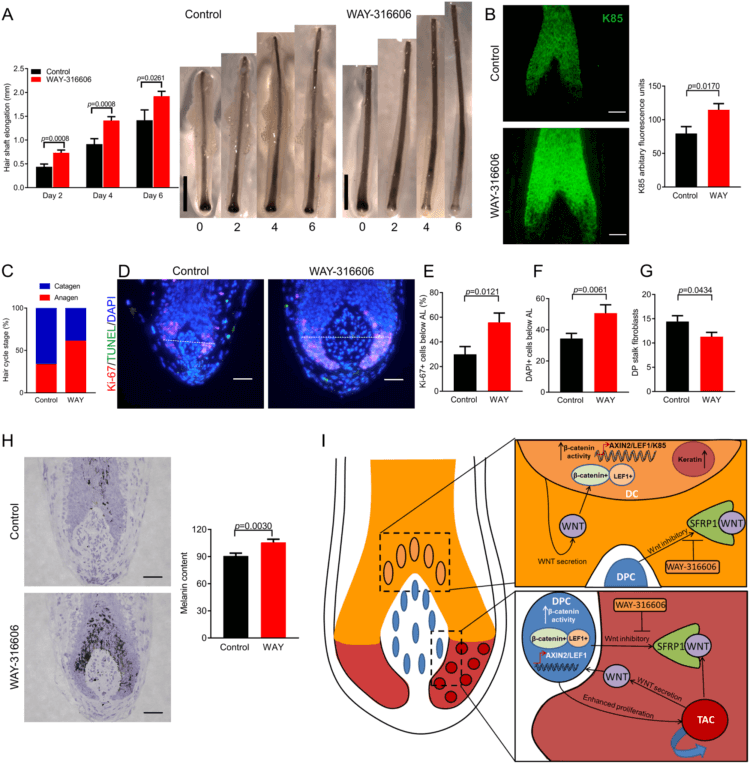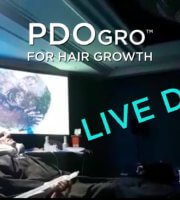A novel strategy for stimulating hair growth using WAY-316606, an SFRP1 Antagonist via Wnt signaling pathway…
Fig3(ABOVE): Inhibiting SFRP1 activity with WAY-316606 enhances human hair growth, increases K85 protein expression, and inhibits spontaneous catagen ex vivo.
Recently touted in this popular news story entitled “Shampoo containing brittle bones drug allegedly triggers hair growth” https://www.foxnews.com/health/2018/05/09/shampoo-containing-brittle-bones-drug-allegedly-triggers-hair-growth.html, the scientific research behind this story and WAY-316606 is true and not “fake news,” but the title is VERY misleading. This potentially hair-growing compound is NOT contained in a shampoo or gel in the ex-vivo studies (the studies were done in a petri dish, not on a scalp), and an over-the-counter remedy based on this technology is very, very far off–and may never come to fruition. Here is an excerpt from the original study below… —Dr. Alan Bauman, MD, ABHRS, IAHRS, FISHRS
Identifying novel strategies for treating human hair loss disorders: Cyclosporine A suppresses the Wnt inhibitor, SFRP1, in the dermal papilla of human scalp hair follicles (excerpt)
Nathan J. Hawkshaw, Jonathan A. Hardman, Iain S. Haslam, Asim Shahmalak, Amos Gilhar, Xinhong Lim, Ralf Paus
Published: May 8, 2018 https://doi.org/10.1371/journal.pbio.2003705
https://journals.plos.org/plosbiology/article?id=10.1371%2Fjournal.pbio.2003705
Abstract
Hair growth disorders often carry a major psychological burden. Therefore, more effective human hair growth–modulatory agents urgently need to be developed. Here, we used the hypertrichosis-inducing immunosuppressant, Cyclosporine A (CsA), as a lead compound to identify new hair growth–promoting molecular targets. Through microarray analysis we identified the Wnt inhibitor, secreted frizzled related protein 1 (SFRP1), as being down-regulated in the dermal papilla (DP) of CsA-treated human scalp hair follicles (HFs) ex vivo. Therefore, we further investigated the function of SFRP1 using a pharmacological approach and found that SFRP1 regulates intrafollicular canonical Wnt/β-catenin activity through inhibition of Wnt ligands in the human hair bulb. Conversely, inhibiting SFRP1 activity through the SFRP1 antagonist, WAY-316606, enhanced hair shaft production, hair shaft keratin expression, and inhibited spontaneous HF regression (catagen) ex vivo. Collectively, these data (a) identify Wnt signalling as a novel, non–immune-inhibitory CsA target; (b) introduce SFRP1 as a physiologically important regulator of canonical β-catenin activity in a human (mini-)organ; and (c) demonstrate WAY-316606 to be a promising new promoter of human hair growth. Since inhibiting SFRP1 only facilitates Wnt signalling through ligands that are already present, this ‘ligand-limited’ therapeutic strategy for promoting human hair growth may circumvent potential oncological risks associated with chronic Wnt over-activation.
Author summary
Hair loss is a common disorder and can lead to psychological distress. Cyclosporine A, a fungal metabolite commonly used as an immunosuppressant, can potently induce hair growth in humans. However, it cannot be effectively used to restore hair growth because of its toxic profile. In this study, we used Cyclosporine A as a lead compound to identify novel therapeutic targets that can aid the development of new hair growth–promoting agents. Through microarray analysis, we found that the level of the secreted Wnt inhibitor, SFRP1, was significantly reduced by Cyclosporine A. This inspired us to design a new pharmacological approach that uses WAY-316606, a reportedly well-tolerated and specific antagonist of SFRP1, to prolong the growth phase of the hair cycle. We show that WAY-316606 enhances human hair growth ex vivo, suggesting that it is a more targeted hair growth promoter with the potential to treat human hair loss disorders.
At Bauman Medical, we are closely monitoring these types of research studies which may give rise to safe, therapeutic treatments or cures for hair loss for our patients in the future. Stay tuned for further updates at https://www.baumanmedical.com/news. Hair loss suffers may request a private Virtual Consultation (Skype or FaceTime) or In-Person Consultation with #1 Top Hair Restoration Surgeon, Dr. Alan J. Bauman, MD, ABHRS, IAHRS, FISHRS.
If you or someone you know has hair loss, hair thinning, baldness, or eyebrow / eyelash concerns, click to start either a long-distance virtual consultation OR an in-person, in-office consultation with Dr. Bauman. You can also Ask Dr. Bauman a Question or simply call Bauman Medical Group at +1-
*Each individual's treatment and/or results may vary




 What is the relationship between Baldness, Baldness Drugs, and COVID-19?
What is the relationship between Baldness, Baldness Drugs, and COVID-19? VirtualPRP AnteAGE-MD Clinical Trial Before+After Results
VirtualPRP AnteAGE-MD Clinical Trial Before+After Results What is VirtualPRP and AnteAge-MD Home Hair System?
What is VirtualPRP and AnteAge-MD Home Hair System? VIDEO: PDOgro PDO Thread Procedure for Hair Growth Demo
VIDEO: PDOgro PDO Thread Procedure for Hair Growth Demo Dr. Alan J. Bauman, M.D.Hair Loss & Hair Transplant ExpertBoca Raton, FL
Dr. Alan J. Bauman, M.D.Hair Loss & Hair Transplant ExpertBoca Raton, FL






